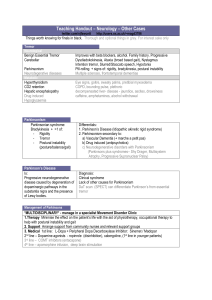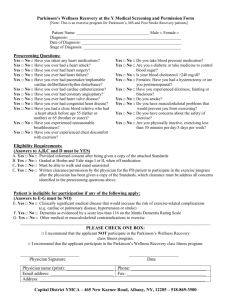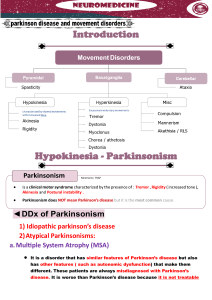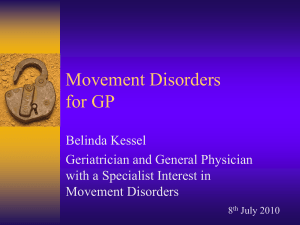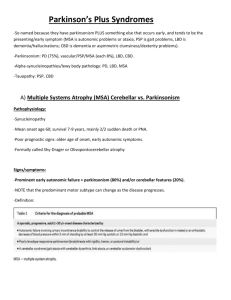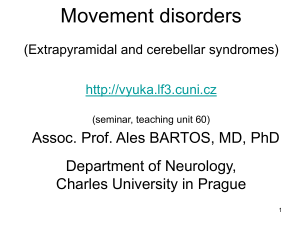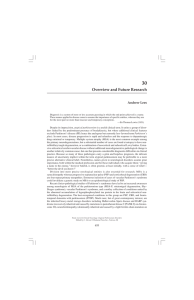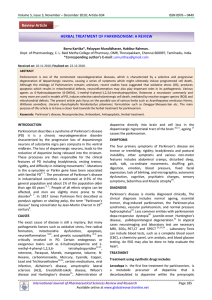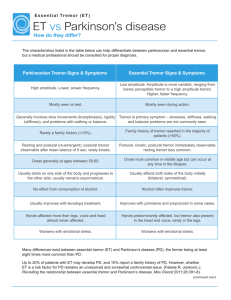The FIVE Stages of Parkinson's Disease
advertisement
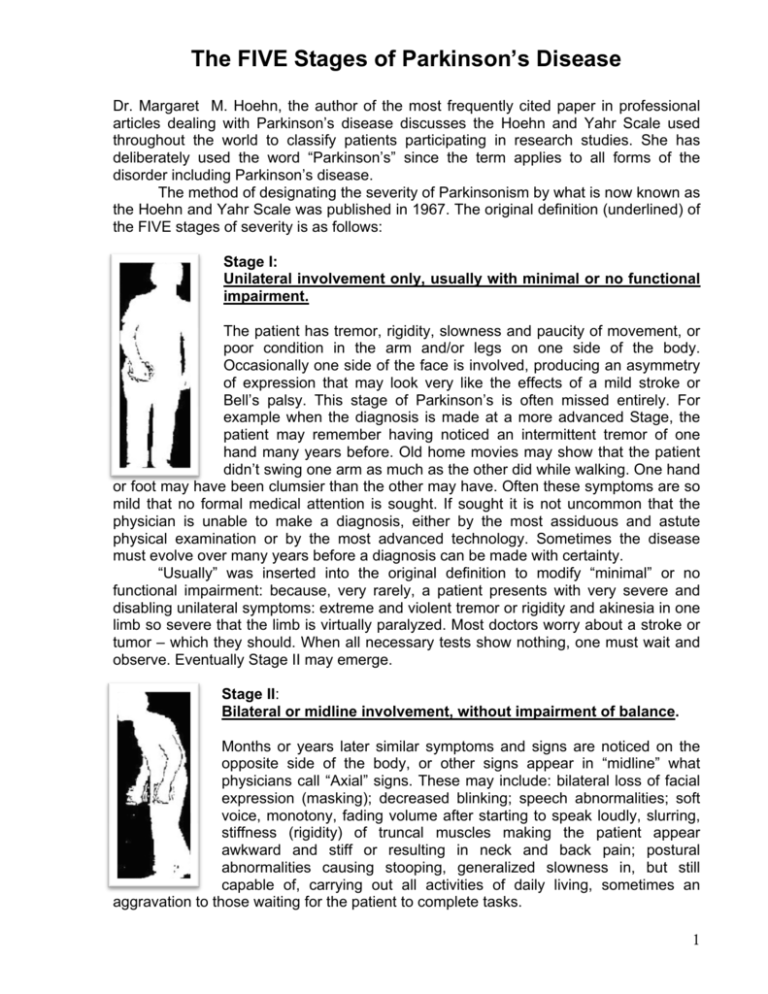
The FIVE Stages of Parkinson’s Disease Dr. Margaret M. Hoehn, the author of the most frequently cited paper in professional articles dealing with Parkinson’s disease discusses the Hoehn and Yahr Scale used throughout the world to classify patients participating in research studies. She has deliberately used the word “Parkinson’s” since the term applies to all forms of the disorder including Parkinson’s disease. The method of designating the severity of Parkinsonism by what is now known as the Hoehn and Yahr Scale was published in 1967. The original definition (underlined) of the FIVE stages of severity is as follows: Stage I: Unilateral involvement only, usually with minimal or no functional impairment. The patient has tremor, rigidity, slowness and paucity of movement, or poor condition in the arm and/or legs on one side of the body. Occasionally one side of the face is involved, producing an asymmetry of expression that may look very like the effects of a mild stroke or Bell’s palsy. This stage of Parkinson’s is often missed entirely. For example when the diagnosis is made at a more advanced Stage, the patient may remember having noticed an intermittent tremor of one hand many years before. Old home movies may show that the patient didn’t swing one arm as much as the other did while walking. One hand or foot may have been clumsier than the other may have. Often these symptoms are so mild that no formal medical attention is sought. If sought it is not uncommon that the physician is unable to make a diagnosis, either by the most assiduous and astute physical examination or by the most advanced technology. Sometimes the disease must evolve over many years before a diagnosis can be made with certainty. “Usually” was inserted into the original definition to modify “minimal” or no functional impairment: because, very rarely, a patient presents with very severe and disabling unilateral symptoms: extreme and violent tremor or rigidity and akinesia in one limb so severe that the limb is virtually paralyzed. Most doctors worry about a stroke or tumor – which they should. When all necessary tests show nothing, one must wait and observe. Eventually Stage II may emerge. Stage II: Bilateral or midline involvement, without impairment of balance. Months or years later similar symptoms and signs are noticed on the opposite side of the body, or other signs appear in “midline” what physicians call “Axial” signs. These may include: bilateral loss of facial expression (masking); decreased blinking; speech abnormalities; soft voice, monotony, fading volume after starting to speak loudly, slurring, stiffness (rigidity) of truncal muscles making the patient appear awkward and stiff or resulting in neck and back pain; postural abnormalities causing stooping, generalized slowness in, but still capable of, carrying out all activities of daily living, sometimes an aggravation to those waiting for the patient to complete tasks. 1 Usually the diagnosis is easy at this Stage if it has been preceded by a clear cut tremor or other symptom on one side. But not all Parkinsonism patients have tremor or other definite signs of Stage I unilateral Parkinsonism. If Stage I was missed and the predominant symptoms at Stage II are only slowness and a lack of spontaneous movement, the diagnosis may still be in doubt. For example, even in Stage II, Parkinsonism may be interpreted as only advancing age. Stage III: First signs of impaired righting reflexes. This is evident as the patient turns or is demonstrated when he or she is pushed from standing equilibrium with the feet together and eyes closed. Loss of balance, with the inability to make the rapid, automatic and involuntary movements necessary to protect against falling, is one of the most troubling and dangerous aspects of Parkinsonism and one of the least easily treated. Even when manifested by only slight unsteadiness, it is the criterion separating Stage II and Stage III. All other aspects of Parkinsonism are evident and usually diagnosis is not in doubt. However, the most important factor identifying Stage III (as opposed to stage IV) is that the patient is still fully independent in all activities of daily living (dressing, hygiene, eating, etc.) Although somewhat restricted, has work potential depending upon the type of employment. A normal life can be. Stage IV: Fully developed, severely disabling disease; the patient is still able to walk and stand unassisted but is markedly incapacitated. The patient is unable to lead an independent life because of the need for help with some activities of daily living. It is this inability to live alone which marks the transition from Stage III to Stage IV. No matter how difficult it is for him/her, if the patient still is able to live alone, his/her disease is at Stage III not Stage IV. The patient at Stage IV however, does remain able to stand and walk unassisted. Stage V: Confinement to bed or wheelchair unless aided. The patient may exhibit: inability to arise from a chair or get out of bed without help; a tendency to fall when standing or turning; freezing, stumbling or pulsion when walking. Without someone immediately present to provide assistance, the patient is in danger of falling. A typical example of diagnosis using this method of staging would be: “a 64 year old with Stage III PD, more marked on the left than the right, of seven years duration.” Another would be: “A 55 year old with severe fluctuations in response to Sinemet, with PD of Stages II/IV, of ten years duration.” The second example indicates that the patient is at Stage II when at his best or “on” and at stage 2 IV when at his worst or “off.” This gives the reader a succinct description of the progression of the disease and the current status of the patient. This method of grading severity is rather a potpourri, combining the symptoms of the patient, the physical signs as observed by the physician and the patient’s functional ability. In some instances, it is not applicable. For example, while general experience has been that is the onset of disturbances of balance that heralds future disability, some patients may have such severe tremor that they are incapacitated even though balance in intact. Others may have mild disturbance of balance for many years without losing independence. There are occasional patients who are more incapacitated by severe unilateral disease than are others by milder bilateral disease. Sometimes Stage I is skipped and the onset is bilateral or generalized. Similarly, many patients never reach Stage V. Patients should not fearfully conclude that when their balance becomes unstable they should immediately start watching for signs indicating that they soon will be dependent upon others. The scale is not linear; that is the patient does not remain at each stage for the same number of years; nor does any stage necessarily represent a given amount of pathology in the brain. In spite of these drawbacks, this method of grading severity has proved practical over many years. It is a simple method, allowing for easily reproducible assessments of the general status and functional level of the patient by independent examiners. Because the definitions of the Stages are very precise, the scale obviates the confusion arising from such poorly defined terms as mild, moderate or severe disease. This has been particularly useful in assessing the reported results of new treatments and in designing research projects, because patients respond differently depending on the disease, age of the patient and other factors. A patient at Stage II can become almost normal with adequate therapy; a patient at Stage IV will have residual symptoms, and improvement is never as marked or dramatic. Obviously, it is important to know the status of patients being described as “successfully” or “unsuccessfully” treated before determining whether a new therapy should be tried in an individual patient. There are other scales for grading the severity of Parkinsonism: The Unified Parkinson’s Disease Rating Scale (UPDRS), the modified Columbia Scale, The Webster Scale, The Schwab and England Disability Scale, the Northwestern University Disability Scale and numerous others, each having its own proponents and usefulness. Reprinted May 2002 with permission from The United Parkinson’s Foundation and provided for your information by PARKINSON’S RESOURCE ORGANIZATION 74-090 El Paseo Suite 104 Palm Desert, CA. 92260 760 773-5628 For more information on Parkinson’s please visit www.parkinsonsresource.org “Working so no one is isolated because of Parkinson’s” 3
